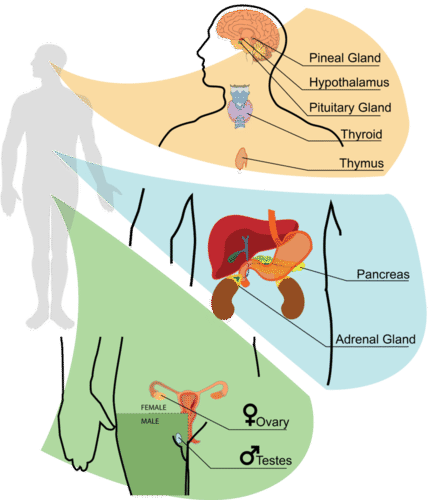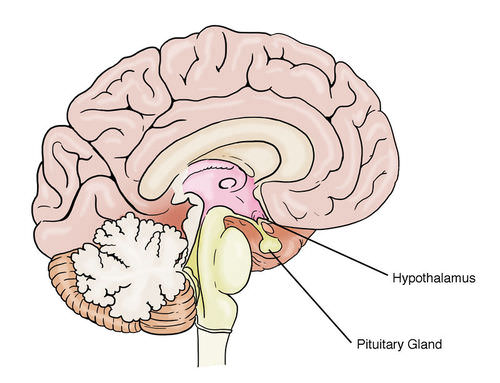13.12: Endocrine Glands
- Page ID
- 13288
\( \newcommand{\vecs}[1]{\overset { \scriptstyle \rightharpoonup} {\mathbf{#1}} } \)
\( \newcommand{\vecd}[1]{\overset{-\!-\!\rightharpoonup}{\vphantom{a}\smash {#1}}} \)
\( \newcommand{\dsum}{\displaystyle\sum\limits} \)
\( \newcommand{\dint}{\displaystyle\int\limits} \)
\( \newcommand{\dlim}{\displaystyle\lim\limits} \)
\( \newcommand{\id}{\mathrm{id}}\) \( \newcommand{\Span}{\mathrm{span}}\)
( \newcommand{\kernel}{\mathrm{null}\,}\) \( \newcommand{\range}{\mathrm{range}\,}\)
\( \newcommand{\RealPart}{\mathrm{Re}}\) \( \newcommand{\ImaginaryPart}{\mathrm{Im}}\)
\( \newcommand{\Argument}{\mathrm{Arg}}\) \( \newcommand{\norm}[1]{\| #1 \|}\)
\( \newcommand{\inner}[2]{\langle #1, #2 \rangle}\)
\( \newcommand{\Span}{\mathrm{span}}\)
\( \newcommand{\id}{\mathrm{id}}\)
\( \newcommand{\Span}{\mathrm{span}}\)
\( \newcommand{\kernel}{\mathrm{null}\,}\)
\( \newcommand{\range}{\mathrm{range}\,}\)
\( \newcommand{\RealPart}{\mathrm{Re}}\)
\( \newcommand{\ImaginaryPart}{\mathrm{Im}}\)
\( \newcommand{\Argument}{\mathrm{Arg}}\)
\( \newcommand{\norm}[1]{\| #1 \|}\)
\( \newcommand{\inner}[2]{\langle #1, #2 \rangle}\)
\( \newcommand{\Span}{\mathrm{span}}\) \( \newcommand{\AA}{\unicode[.8,0]{x212B}}\)
\( \newcommand{\vectorA}[1]{\vec{#1}} % arrow\)
\( \newcommand{\vectorAt}[1]{\vec{\text{#1}}} % arrow\)
\( \newcommand{\vectorB}[1]{\overset { \scriptstyle \rightharpoonup} {\mathbf{#1}} } \)
\( \newcommand{\vectorC}[1]{\textbf{#1}} \)
\( \newcommand{\vectorD}[1]{\overrightarrow{#1}} \)
\( \newcommand{\vectorDt}[1]{\overrightarrow{\text{#1}}} \)
\( \newcommand{\vectE}[1]{\overset{-\!-\!\rightharpoonup}{\vphantom{a}\smash{\mathbf {#1}}}} \)
\( \newcommand{\vecs}[1]{\overset { \scriptstyle \rightharpoonup} {\mathbf{#1}} } \)
\(\newcommand{\longvect}{\overrightarrow}\)
\( \newcommand{\vecd}[1]{\overset{-\!-\!\rightharpoonup}{\vphantom{a}\smash {#1}}} \)
\(\newcommand{\avec}{\mathbf a}\) \(\newcommand{\bvec}{\mathbf b}\) \(\newcommand{\cvec}{\mathbf c}\) \(\newcommand{\dvec}{\mathbf d}\) \(\newcommand{\dtil}{\widetilde{\mathbf d}}\) \(\newcommand{\evec}{\mathbf e}\) \(\newcommand{\fvec}{\mathbf f}\) \(\newcommand{\nvec}{\mathbf n}\) \(\newcommand{\pvec}{\mathbf p}\) \(\newcommand{\qvec}{\mathbf q}\) \(\newcommand{\svec}{\mathbf s}\) \(\newcommand{\tvec}{\mathbf t}\) \(\newcommand{\uvec}{\mathbf u}\) \(\newcommand{\vvec}{\mathbf v}\) \(\newcommand{\wvec}{\mathbf w}\) \(\newcommand{\xvec}{\mathbf x}\) \(\newcommand{\yvec}{\mathbf y}\) \(\newcommand{\zvec}{\mathbf z}\) \(\newcommand{\rvec}{\mathbf r}\) \(\newcommand{\mvec}{\mathbf m}\) \(\newcommand{\zerovec}{\mathbf 0}\) \(\newcommand{\onevec}{\mathbf 1}\) \(\newcommand{\real}{\mathbb R}\) \(\newcommand{\twovec}[2]{\left[\begin{array}{r}#1 \\ #2 \end{array}\right]}\) \(\newcommand{\ctwovec}[2]{\left[\begin{array}{c}#1 \\ #2 \end{array}\right]}\) \(\newcommand{\threevec}[3]{\left[\begin{array}{r}#1 \\ #2 \\ #3 \end{array}\right]}\) \(\newcommand{\cthreevec}[3]{\left[\begin{array}{c}#1 \\ #2 \\ #3 \end{array}\right]}\) \(\newcommand{\fourvec}[4]{\left[\begin{array}{r}#1 \\ #2 \\ #3 \\ #4 \end{array}\right]}\) \(\newcommand{\cfourvec}[4]{\left[\begin{array}{c}#1 \\ #2 \\ #3 \\ #4 \end{array}\right]}\) \(\newcommand{\fivevec}[5]{\left[\begin{array}{r}#1 \\ #2 \\ #3 \\ #4 \\ #5 \\ \end{array}\right]}\) \(\newcommand{\cfivevec}[5]{\left[\begin{array}{c}#1 \\ #2 \\ #3 \\ #4 \\ #5 \\ \end{array}\right]}\) \(\newcommand{\mattwo}[4]{\left[\begin{array}{rr}#1 \amp #2 \\ #3 \amp #4 \\ \end{array}\right]}\) \(\newcommand{\laspan}[1]{\text{Span}\{#1\}}\) \(\newcommand{\bcal}{\cal B}\) \(\newcommand{\ccal}{\cal C}\) \(\newcommand{\scal}{\cal S}\) \(\newcommand{\wcal}{\cal W}\) \(\newcommand{\ecal}{\cal E}\) \(\newcommand{\coords}[2]{\left\{#1\right\}_{#2}}\) \(\newcommand{\gray}[1]{\color{gray}{#1}}\) \(\newcommand{\lgray}[1]{\color{lightgray}{#1}}\) \(\newcommand{\rank}{\operatorname{rank}}\) \(\newcommand{\row}{\text{Row}}\) \(\newcommand{\col}{\text{Col}}\) \(\renewcommand{\row}{\text{Row}}\) \(\newcommand{\nul}{\text{Nul}}\) \(\newcommand{\var}{\text{Var}}\) \(\newcommand{\corr}{\text{corr}}\) \(\newcommand{\len}[1]{\left|#1\right|}\) \(\newcommand{\bbar}{\overline{\bvec}}\) \(\newcommand{\bhat}{\widehat{\bvec}}\) \(\newcommand{\bperp}{\bvec^\perp}\) \(\newcommand{\xhat}{\widehat{\xvec}}\) \(\newcommand{\vhat}{\widehat{\vvec}}\) \(\newcommand{\uhat}{\widehat{\uvec}}\) \(\newcommand{\what}{\widehat{\wvec}}\) \(\newcommand{\Sighat}{\widehat{\Sigma}}\) \(\newcommand{\lt}{<}\) \(\newcommand{\gt}{>}\) \(\newcommand{\amp}{&}\) \(\definecolor{fillinmathshade}{gray}{0.9}\)
What's a hormone?
This messenger pigeon is delivering a letter, making sure it gets to where it needs to go. It could be said that hormones are biological messengers, and they originate from the endocrine system. The nervous system isn’t the only message-relaying system of the human body. The endocrine system also carries messages. The endocrine system is a system of glands that release chemical messenger molecules into the bloodstream. The messenger molecules are hormones. Hormones act slowly compared with the rapid transmission of electrical messages by the nervous system. They must travel through the bloodstream to the cells they affect, and this takes time. On the other hand, because endocrine hormones are released into the bloodstream, they travel throughout the body. As a result, endocrine hormones can affect many cells and have body-wide effects.
Glands of the Endocrine System
The major glands of the endocrine system are shown in Figure below. You can access a similar, animated endocrine system chart at the link below.

Hypothalamus
The hypothalamus is actually part of the brain (see Figure below), but it also secretes hormones. Some of its hormones “tell” the pituitary gland either to secrete or to stop secreting its hormones. In this way, the hypothalamus provides a link between the nervous and endocrine systems. The hypothalamus also produces hormones that directly regulate body processes. These hormones travel to the pituitary gland, which stores them until they are needed. The hormones include antidiuretic hormone and oxytocin.
- Antidiuretic hormone stimulates the kidneys to conserve water by producing more concentrated urine.
- Oxytocin stimulates the contractions of childbirth, among other functions.
 The hypothalamus and pituitary gland are located close together at the base of the brain.
The hypothalamus and pituitary gland are located close together at the base of the brain.Pituitary Gland
The pea-sized pituitary gland is attached to the hypothalamus by a thin stalk (see Figure above). It consists of two bulb-like lobes. The posterior (back) lobe stores hormones from the hypothalamus. The anterior (front) lobe secretes pituitary hormones. Several pituitary hormones and their effects are listed in Table below. Most pituitary hormones control other endocrine glands. That’s why the pituitary is often called the “master gland” of the endocrine system.
| Hormone | Target | Effect(s) |
|---|---|---|
| Adrenocorticotropic hormone (ACTH) | Adrenal glands | Stimulates the cortex of each adrenal gland to secrete its hormones. |
| Thyroid-stimulating hormone (TSH) | Thyroid gland | Stimulates the thyroid gland to secrete thyroid hormone. |
| Growth hormone (GH) | Body cells | Stimulates body cells to synthesize proteins and grow. |
| Follicle-stimulating hormone (FSH) | Ovaries, testes | Stimulates the ovaries to develop mature eggs; stimulates the testes to produce sperm. |
| Luteinizing hormone (LH) | Ovaries, testes | Stimulates the ovaries and testes to secrete sex hormones; stimulates the ovaries to release eggs. |
| Prolactin (PRL) | Mammary glands | Stimulates the mammary glands to produce milk. |
Other Endocrine Glands
Other glands of the endocrine system are described below. You can refer to Figure above to see where they are located.
- The thyroid gland is a large gland in the neck. Thyroid hormones increase the rate of metabolism in cells throughout the body. They control how quickly cells use energy and make proteins.
- The two parathyroid glands are located behind the thyroid gland. Parathyroid hormone helps keep the level of calcium in the blood within a narrow range. It stimulates bone cells to dissolve calcium in bone matrix and release it into the blood.
- The pineal gland is a tiny gland located at the base of the brain. It secretes the hormone melatonin. This hormone controls sleep-wake cycles and several other processes.
- The pancreas is located near the stomach. Its hormones include insulin and glucagon. These two hormones work together to control the level of glucose in the blood. Insulin causes excess blood glucose to be taken up by the liver, which stores the glucose as glycogen. Glucagon stimulates the liver to break down glycogen into glucose and release it back into the blood. The pancreas also secretes digestive enzymes into the digestive tract.
- The two adrenal glands are located above the kidneys. Each gland has an inner and outer part. The outer part, called the cortex, secretes hormones such as cortisol, which helps the body deal with stress, and aldosterone, which helps regulate the balance of minerals in the body. The inner part of each adrenal gland, called the medulla, secretes fight-or-flight hormones such as adrenaline, which prepare the body to respond to emergencies. For example, adrenaline increases the amount of oxygen and glucose going to the muscles.
- The gonads secrete sex hormones. The male gonads are called testes. They secrete the male sex hormone testosterone. The female gonads are called ovaries. They secrete the female sex hormone estrogen. Sex hormones are involved in the changes of puberty. They also control the production of gametes by the gonads.
Further Reading
Summary
- The endocrine system consists of glands that secrete hormones into the bloodstream.
- The endocrine system is regulated by a part of the brain called the hypothalamus, which also secretes hormones.
- The hypothalamus controls the pituitary gland, which is called the “master gland” of the endocrine system because its hormones regulate other endocrine glands.
- Other endocrine glands include the thyroid gland and pancreas.
Review
- Explain how the nervous system is linked with the endocrine system.
- List five of the major glands of the endocrine system.
- Name three pituitary hormones, and state how they affect their targets.
| Image | Reference | Attributions |
 |
[Figure 1] | Credit: Laura Guerin Source: CK-12 Foundation License: CC BY-NC 3.0 |
 |
[Figure 2] | Credit: Mariana Ruiz Villarreal (LadyofHats) for CK-12 Foundation Source: CK-12 Foundation License: CC BY-NC 3.0 |
 |
[Figure 3] | Credit: Laura Guerin Source: CK-12 Foundation License: CC BY-NC 3.0 |

